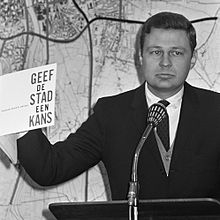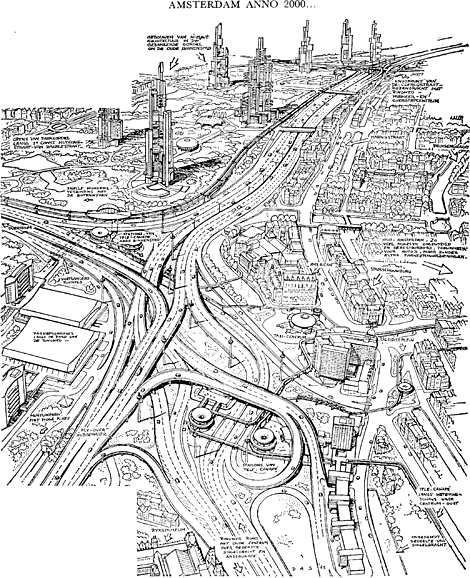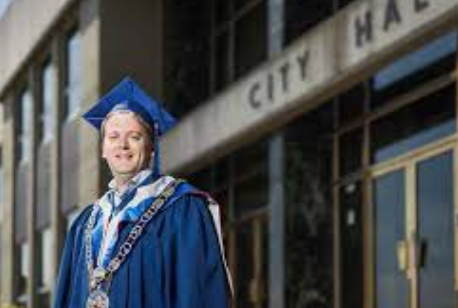
Imagine the Netherlands in the 1960’s. It is a place where traffic and automobiles have become ubiquitous in the post war era. Where to look for inspiration on how to move more people more efficiently? The United States. Specifically American David Jokinen, an engineer who had the Big Idea to create bigger highways between cities and suburbs was hired.
In 1962 and in 1967 Jokinen created two traffic plans for The Hague and for Amsterdam respectively. In Amsterdam part of the plan was also for new metro lines to be constructed, demolishing housing in the Niewmarkt neighbourhood. Locals tried to stop the buildings from being demolished, resulting in the Niewmarkt riot. While the housing was lost, the expansion of the metro was halted, meaning that the centre of Amsterdam was kept intact.
While Jokinen’s plans were not implemented in the Hague, he received funding from the Stichting Weg automobile lobby in Amsterdam, whose sole purpose was to create better access by car. Jokinen was going to create a six lane highway and demolish several Amsterdam neighbourhoods, with a highway serving the city’s downtown to facilitate access to work by car.

Remember this is the time of Disneyland~Jokinen wanted monorails that allowed access from parking garages at the city’s periphery into the downtown. In many accounts, Jokinen’s concepts are compared to that of Robert Moses who was shaping New York City in a similar car oriented way. It’s also similar to the plan announced in 1967 for Vancouver which proposed replacing the inner city neighbourhoods of Strathcona and Chinatown with elevated highways and an “LA-style cloverleaf interchange.”
But for citizens of Amsterdam, this plan was a step up from that of the Kaasjager Plan which in 1954 actually suggested burying the city’s iconic canals to facilitate more road space.
Thankfully the plan received some very plain speaking Dutch criticism and besides a few viaducts was never completed. You can take a look at the plan (which ironically was called “Give the City A Chance” and the images of 1960’s Amsterdam in this YouTube video below produced by “Not Just Bikes”.












I can’t think of too many modern professions whose notions of best practice have so dramatically reversed in 40 years, with the possible exception of fewer doctors who smoke. Which of our current “can’t-lose” practices will make future contemporaries dramatically headslap themselves at our monumental stupidity?
I’m asking PT readers for their opinions. Who’s got the best submission for “What do Planners currently think they’re doing right that society is one day most likely to see as dumber than the pet rock?” Unfortunately we can’t award a winner until the mid 2040’s at the earliest, but I’m sure it’ll be worth the wait!
Gee, what a good thing the Dutch managed to stop two metro lines in Amsterdam.
https://www.amsterdam.info/transport/metro/
The metro may have been delayed. The ghastly highway was stopped. An excellent trade off.
Meanwhile they had trams all along.
https://amsterdammap360.com/amsterdam-tram-map#.Xbh_jJJKi70